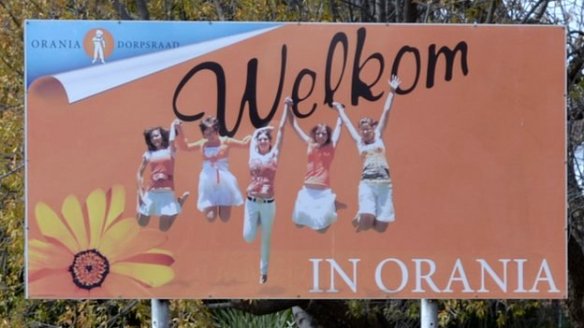
The whites-only town of Orania is in the news again in a new BBC article that appeared on October 6th.
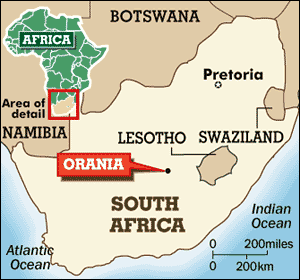 Orania, a small town of 1,300 people in the Northern Cape in South Africa, was founded in 1991 as an Afrikaner-only town, where only Afrikaans is spoken.
Orania, a small town of 1,300 people in the Northern Cape in South Africa, was founded in 1991 as an Afrikaner-only town, where only Afrikaans is spoken.
Orania was the brainchild of Carel Boshoff III. The son-in-law of H.F. Verwoerd, the architect of apartheid, he and a number of families purchased an abandoned workers’ village with lofty ambitions that one day hundreds of thousands of Afrikaners might call it home.
When Boshoff III died in 2011, his son Carel Jr. assumed presidency of the Orania Movement, the political arm of the community. Today he is their lead spokesperson.
“We do not fit in easily in the new South Africa. It [Orania] was an answer to not dominating others and not being dominated by others,” says Boshoff Jr.
Orania has proved to be the answer for those Afrikaners who felt displaced in the land their people had ruled for many decades. They feared the loss of their culture, heritage, and jobs in the new democratic South Africa. They especially were afraid economically by the effects of such policies as affirmative action and Black Economic Empowerment (BEE), which encouraged more black participation in business. Orania, to these Afrikaners, was a way to preserve their identity and livelihoods amidst a South Africa that was trying to right the wrongs of the past 300 years of racial segregation and oppression.
One local explains the new South Africa as “reverse racism”.
“We can’t get jobs. It’s like we are being punished for the past,” he says.
“I see nothing wrong with apartheid,” says Martin Kemp, one of the older residents.
“Of course you get the petty apartheid: ‘You use this toilet I use that toilet’, I don’t think that was necessary but the real apartheid as Dr Verwoerd saw it, there was nothing wrong with it,” he said.
Orania’s supporters are quick to point out that it exists within the parameters of the law. The post-apartheid government allowed for the concept of an Afrikaner state within the new constitution under freedom of self-determination on cultural and linguistic grounds.
The town is built on private land owned by the Orania Company, with shares held by homeowners. As such, the community is able to maintain more control over who is permitted into the collective.

Nelson Mandela during his visit to Orania in 1995
Black people cannot live here. Prospective residents are screened by the town council using a strict criterion, which includes first and foremost being an ethnic Afrikaner. Simply speaking Afrikaans, being a member of the Dutch Reformed Church, or even just being white is not enough.
Orania officials say the town’s safety and economic prosperity show that their model is one that works, as opposed to the new South Africa. Town officials cite an annual growth rate of nearly 10% since its inception 23 years ago.
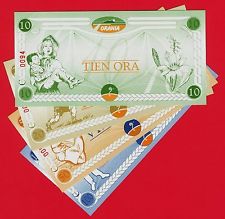 The town boasts shops, hair salons, a library, a post office, a hotel, schools, and churches. They even have their own currency, the Ora, which is pegged to the South African rand.
The town boasts shops, hair salons, a library, a post office, a hotel, schools, and churches. They even have their own currency, the Ora, which is pegged to the South African rand.
A statue of Hendrik Verwoerd welcomes people to the town, while busts of former Afrikaner leaders – Paul Kruger, JBM Herzog, DF Malan, JG Strydom, and Verwoerd – and old apartheid-era flags decorate the landscape.
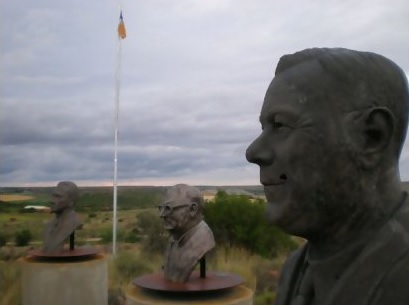
Orania is not alone, however.Today there are as many as 400 white informal settlements in South Africa where 7,754 white households live, according to charity Helping Hand.
The scary part of Orania is not just that it exists, but that the town’s inhabitants feel that it needs to exist. They also see apartheid as a positive aspect of the past that they are desperately keeping alive, despite it having been declared as a crime against humanity by the United Nations as early as the 1960s. But it is an interesting discussion: What does a town like Orania say about South Africa today? Should a town like this be allowed to exist? What do you think?

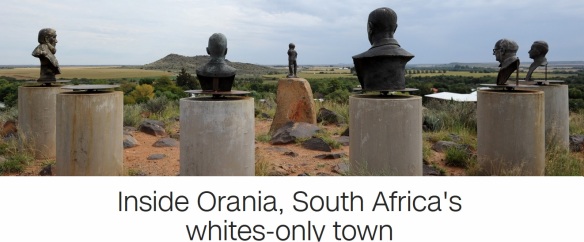
Pingback: The Eden Project: The latest attempt at creating a “White’s Only” enclave in South Africa | A Vermont Teacher's Journey to the Rainbow Nation
Many such places exist in South Africa, Zululand, The Old Transkei (where the chiefdom can let you be thrown over a cliff for your misbehavior!), Grikwaland and various other areas where only certain ethnic people are allowed to live and own property, if you drive north from Pretoria, just about 50km, you will find Mamalodi, try to find one Afrikaner there, you will fail. The same goes for “Witsieshoek” next to the “Eastern Freestate”, Strickly Basotho Only the same with Thaba Nchu and Botshabelo (not “Townships”, these are vast areas where only certain ethnic groups can live and own property!) I can list maybe 50 such towns or even more. Why do people feel that Afrikaners should not have their own cultural community area? Orania is tiny with regard to the other cultural and ethnic-specific areas of SA.
You also fail to mention that the borders of SA were drawn by the British Colonial Regime, who conquered SA in a devastating war and mainly forcibly moved people to today’s “urban” areas to work on the gold mines. Furthermore, you offer a simplistic view of SA and its diversity or the lack thereof in some areas the entire structure of separation between ethnic lines in the urban areas were created by the British and not by “Apartheid”, the later was simply a system of separation that was inherited by the leaders of the post-colonial RSA, “Apartheid” was only a name given to a system that aimed to correct some of the displacement by the colonial rule. Of course, some of it corrupted just like the ANC is devastating SA with corruption and racial discrimination against an extremely vulnerable minority.
Should Orania Exist and be allowed to be autonomous…of course…just like all other largely autonomous and far less corruption-plagued regions of SA that deserve al our support.
Thanks for your comment, although I have to disagree with you on a number of points.
I have been to Thaba Nchu and Botshabelo, and these are definitely townships no different than in the apartheid years. The location, streets, housing, etc. was set up by the apartheid government on the outskirts of cities and towns for the sole purpose of keeping black and colored South Africans out of the “whites-only” cities. These were designated by the apartheid regime by ethnicity, so yes, many of these townships are set up along ethnic lines but that was due to government decree during apartheid. So when apartheid ended, many could not afford to move out of the townships and therefore they have stayed there since 1994. But it is not illegal to live in these areas if you are not of a certain ethnicity like the officials in Orania are making it.
You are also incorrect in stating that it was the British who drew the borders and colonized the country of South Africa. Yes, the British certainly had a lot of influence but they didn’t officially start showing up until the late 1700s. The Dutch had been in the Cape since 1652, establishing the basis for apartheid. Apartheid as an ideology, belief, and practice, is rooted in the arrival of Jan Van Riebeeck and the Dutch East India Company in 1652. According to Clark and Worger, in South Africa: The Rise and Fall of Apartheid, “racial discrimination did not begin in South Africa in 1948. Indeed, it can be traced back to the beginnings of Dutch colonization of the Cape of Good Hope in 1652.” It was the Dutch, and later their descendants, the Boers/Afrikaners, who created the system of racial oppression and segregation by the way they treated the Khoi and San upon arrival. You are certainly correct that the British were driven by greed and thus created conditions to keep black Africans as cheap labor for the gold and diamond mines, but the process of kicking people off their land was also occurring at the hands of the Boers, as well. Please do not act like the Boers were saints and never committed any atrocities against black Africans.
Also, to state that apartheid was “simply a system of separation” is a gross misrepresentation of historical reality. Apartheid was one of the most repressive and violent systems of oppression in the 20th century. The constitution of South Africa forcibly kept the majority of people oppressed due to skin color, and enforced this through military and police brutality and force. This is not “separation” as Verwoerd would like you to believe when he said this in 1961.
I hope you can take some time to read some of the resources in my Books section of this blog as that will shed some light onto the reality of apartheid.
Thanks,
Craig
It is true that apartheid was cruel and unjust. However when compared to the bLack crimes and unrmploument, that are now tearing South Africa apart, apartheid was a hundred times better. At least the blacks has food eat and there w as no unemployment, Now they have neither food nor work.
Thank you for your comment, but I strongly disagree. Your argument that “apartheid was a hundred times better” is not based in reality but is rather historical revisionism. Apartheid was one of the most brutal and repressive systems in the 20th century and it led to the deaths of 1.5 million people throughout southern Africa, according to Allister Sparks. It was internationally reviled and its overthrow was one of the greatest moments in world history of the last century.
I’m sorry but your assessment of food, employment, rights, and quality of life today is immeasurably better in South Africa today than under apartheid. In terms of employment, black Africans were barred from competing for positions that were reserved for whites. The National Party that won the 1948 election endorsed the Civilized Labor Policy. Blacks who were admitted to urban areas were relegated to doing manual and unskilled labor. As Hendrik Verwoerd clearly stated, “There is no place for him in the European community above the level of certain forms of labor.” The education system for black African was purposefully underfunded to keep Africans at the level of menial labor. By 1962, expenditure per black child per year was about R12 while the expenditure per white child was R158. This is clear that employment was designed under apartheid to be unequal and exploitative.
When you claim that “blacks had food to eat” under apartheid, this is also not an accurate representation of the experience and struggles of black Africans. Apartheid created and enforced a system that kept the black population in abject poverty, thus creating conditions of widespread malnutrition and hunger. This was especially true in the homelands where more than 3.5 million black Africans were forcibly relocated to during apartheid in what can only be described as ethnic cleansing. This led to a vast difference in life expectancy, where in 1979, the white life expectancy was 64.5 years, while the black African life expectancy was 52 years.
No matter how you want to try to reimagine the past, apartheid was one of the most oppressive and cruel systems of the 20th century and not only South Africa, but the whole world, is better for having it overthrown.